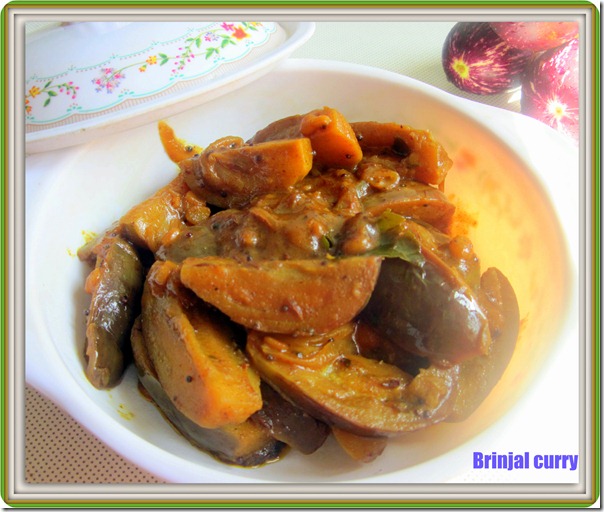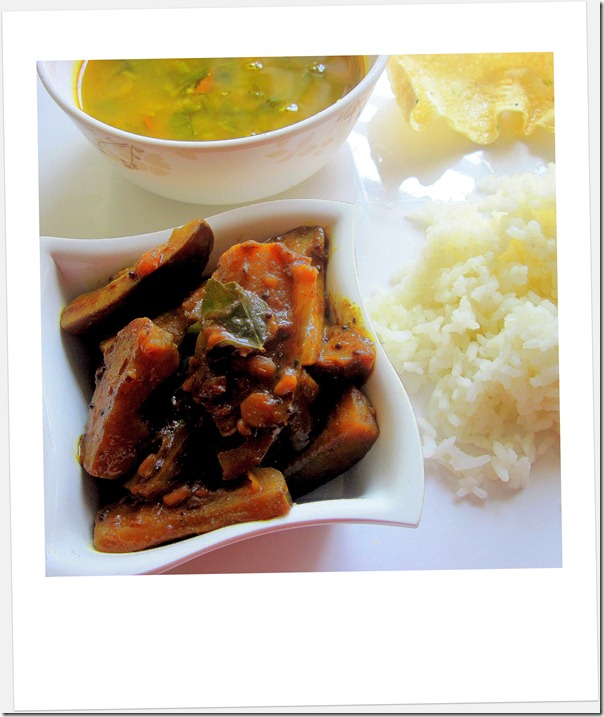Spanish Recipes posted a photo:
domingo, 14 de abril de 2013
EASY BRINJAL CURRY|KATHRIKAI PORIYAL
I learnt this recipe from my neighbor. I am a big fan of brinjal but my hubby is just opposite to me. So i rarely buy this veggie and cook for me specially. I love my mom's brinjal stuffed poriyal very much. Next to that , this is the second best. It can be made in jiffy. It tastes best with dal , sambhar and morkuzhambu rice. I relished with keerai kuzhambu ..!!
INGREDIENTS
To temper & saute
|
METHOD
- Slit cut each brinjal into 8 pieces .Make thin slices so that it cooks quickly.Immerse in water till use. Soak tamarind in little water.
- Heat oil in a kadai and temper all the items given above in the same order.
- Saute onions till it turns transparent.Add the brinjal slices and saute for a minute.
- Add the sambhar powder ,saute for sometime.Then add the tamarind extract , jaggery ,required water & salt.
- Cover and cook for sometime.Switch off the flame once the brinjal is cooked.
****If u want in semi gravy consistency , switch off the flame when little water remains.It can be mixed in plain rice topped with ghee !!
Yummy brinjal curry is ready is to serve with dal rice , sambhar & morkuzhambu rice!!
NOTE
- Use long green brinjal variety. But i used the normal purple ones.
- When i made this curry , i had cut the brinjal into 4 pieces so it was big to eat. Then my neighbour told me cut into very small , thin slices the next time. I found the taste was blended well when brinjal is small.
KITCHEN CLINIC
| BRINJAL Commonly known as the eggplant, brinjal is one of the most easily available and affordable vegetables. In its unripe form, it is a large greenish-whitish vegetable and when ripe, it turns a deep violet. Brinjal can be cooked in many different ways and provides many essential nutrients that are needed for overall well-being of the body. In fact, one can even take brinjal soup to attain maximum benefits from this vegetable. It is a very good source of potassium and contains a high content of water and fiber. Check out the nutritional value and also the health benefits of eating brinjal. Nutritional Value of Brinjal Given here is the nutritional value of a serving of 100 grams of brinjal.
Health & Nutrition Benefits of Eating Brinjal
|
viernes, 12 de abril de 2013
http://feedproxy.google.com/~r/blogspot/sBff/~3/fIDBEVNhKs0/root-vegetable-gratin-notes-from.html
I understand that there've been times when we literally had no choice – it was either gnaw on a parsnip or perish, but nowadays with so many other delicious choices, why would anyone eat root vegetables on purpose? Has anyone ever stumbled out of a smoky dorm room late at night, in search of a big plate of steamed turnips? Probably not.
So, while you'll never catch me boiling up a batch of these fugly roots to enjoy their intoxicating sulphurous savoriness, I have been known to tolerate them in the occasional gratin.



